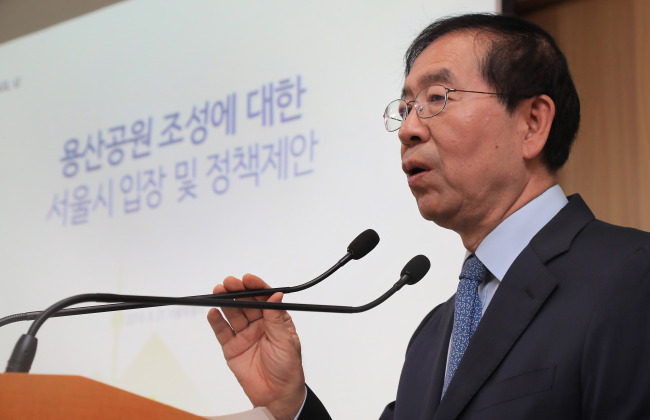Seoul Mayor Park Won-soon on Wednesday denounced the central government’s overlapping plan to utilize the land in Yongsan following the scheduled relocation of the US troops next year. He said the city will continue to draw up detailed plans to create an urban park upholding the historical value of the site.
After several rounds of talks stretching decades, South Korea and the US agreed in 2004 to relocate the US military headquarters in Yongsan to an expanded military base in Pyeongtaek, Gyeonggi Province. In 2010, both agreed to complete the relocation by 2017.
 |
Seoul Mayor Park Won-soon speaks during the press conference at the City Hall on Wednesday. (Yonhap) |
The US Army Garrison in Yongsan was first set up in 1945, allowing US troops to hold de facto control of the Yongsan region for its strategic location in the capital after South Korea became independent.
Giving an example of Stanley Park -- the park that borders the downtown of Vancouver in British Columbia, Canada -- Mayor Park said that building Yongsan Park can decide Seoul’s future and reputation as a city landmark.
“Stanley Park is one of the most beloved parks that was created by the Vancouver City Council to celebrate the first year of independence from the UK,” said Park during the press conference at City Hall.
“As you can see, the park became Vancouver’s pride and a historical symbol, appreciated by citizens who can enjoy the green oasis in the city as well as to remember the historical meaning,” he added.
In 2006 the SMG announced it would turn the Yongsan base area into a park larger than London’s Hyde Park when US troops move out.
However, its initial plan to fully use the 3.58 million square meters of the land fell through, as central government ministries competed for use of the land.
According to city government, state organizations, such as the Defense Acquisition Program Administration, have beaten the city to reserve the use of 930,000 square meters of land.
Another 220,000 square meters of land will be handed to US troops for the relocation of the US embassy in 2019. Additional distribution of the remaining land lots can be made to the US upon their request.
Currently, 68 percent of the site can be turned into a park.
In 1992, some 290,000 square meters of land, including a golf course, was returned to the city government for the use of the site for the National Museum of Korea and Yongsan Family Park.
Park claimed that the Ministry of Land, Infrastructure and Transport unilaterally pushed its position to use the land without considering the purpose or value of the park.
In May, the Ministry of Land, Infrastructure and Transport announced its plan to build a national science museum following the relocation of US troops.
Park contended that there are a number of historical and cultural resources in the Yongsan area, including a prison that was used during the Japanese colonization era.
“Based on our blueprint for the park, we will first set up a data bank and research archive to study the historical value of Yongsan, and ultimately apply for UNESCO listing,” Park said.
The Seoul Metropolitan Government also added it would actively support citizens to engage in creating the park by operating citizen-run design labs and seminars.
By Kim Da-sol(
ddd@heraldcorp.com)








![[Today’s K-pop] Blackpink’s Jennie, Lisa invited to Coachella as solo acts](http://res.heraldm.com/phpwas/restmb_idxmake.php?idx=644&simg=/content/image/2024/11/21/20241121050099_0.jpg)